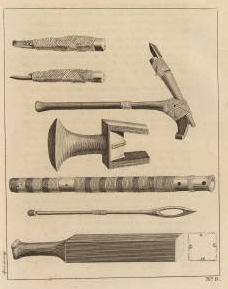 |
| 1886.1.1550 Barkcloth Beater |
Forster 24 is 'A large clothbeater' from Tahiti. Barkcloth beaters from Tahiti were usually made from ironwood or toa (Casuarina equisetifolia). Kooijman reports in 'Tapa in Polynesia' (Bernice P. Bishop Museum Bulletin 234, Hawaii 1972) that in addition to the general Polynesian term ie for beaters, the word toa was also used.
In general, beaters were square in section, with the corners rounded off to form the shaft. Each side of the beater was grooved, with the grooves increasing in fineness. The beater was used to beat out the inner bark of whichever tree was being used to make the barkcloth - usually the paper mulberry (Broussonetia papyrifera) but the breadfruit (Artocarpus sp.) and types of fig tree were also used.
 |
| 'Native implements, Otaheite'from Hawkesworth, 1773, showing a barkcloth beater. |
Barkcloth beating took place in a special shed, and each family had such a shed. The strips of prepared inner bark, two or three layers thick and damp, having been soaked in water overnight, were laid on a wooden anvil (tutu or tutua). The anvil could be up to 9 meters long, with a width of up to 25cm. Beating started with the coarsest side of the beater. As the bark became thinner and started to spread out, it was necessary to move progressively to the finer-grooved sides, ending with the finest.
 |
| Bark fibres caught in the finest side of the barkcloth beater (x10) |
The best kind of barkcloth on Tahiti was called hobu, and was made by folding a piece of paper mulberry bark several times while beating. It was kept wet by sprinkling it with water, and was a thinner and softer cloth than ordinary tapa. Joseph Banks described the manufacture of this type of tapa, and said that the very finest kind was made by wearing the hobu until it became even more supple, then washing it and beating it again with the very finest beaters. The tapa was also bleached in the sun, to give it a fine white colour.
Barkcloth manufacture on Tahiti disappeared soon after Western contact, to be replaced with woven cloth. Herman Melville wrote in 1847 that 'the echoes of the cloth-mallet have long since died away in the listless valleys of Tahiti.' (Omoo: A Narrative of Adventures in the South Seas Being a Sequel to the "Residence in the Marquesas Islands").